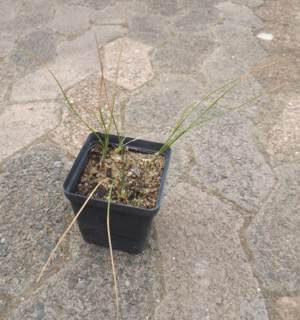Drimia filifolia
Drimia filifolia (Jacq.) J.C.Manning & Goldblatt
Family: Hyacinthaceae
Common names: thread-leaf drimia (Eng.); gifbol (Afr.)
Introduction
Drimia filifolia is an attractive plant, flowering in spring up to early summer and is an asset to any garden. This article will provide some insight into this obscure, yet highly decorative plant.

Description
Description
Drimia filifolia is a bulbous geophyte somewhat similar to D. exuviata, but is smaller, with a height of up to 300 mm, as opposed to D. exuviata, which grows up to 1 m tall. D. filifolia also differs in that it lacks the conspicuous collar found in D. exuviata. Furthermore, Drimia filifolia also produces fewer leaves. They are approximately 1 mm in diameter and are present at flowering, drying out during the summer months.

It produces sweetly fragrant white flowers with brown keels, forming a cluster on a slender, brown inflorescence. Flowers are followed by brown, oval-shaped capsules containing flattened, round seeds, becoming black when mature.
Conservation Status
Status
Drimia filifolia is widespread and has been given a conservation status of Least Concern (LC).
Distribution and habitat
Distribution description
Drimia filifolia is widely distributed along the western side of southern Africa, occurring from Namibia to Swellendam in South Africa. It is found in a variety of habitats, ranging from Strandveld to Renosterveld, where it usually grows in clay soils. It should be grown in winter-rainfall areas which do not experience frost or extreme cold temperatures.

Derivation of name and historical aspects
History
Drimia is derived from the Greek word drymus meaning ‘acrid' or ‘pungent'. Filifolia is derived from the Latin words filum meaning ‘thread' and folium meaning ‘leaves' and refers to the plant's long, slender leaves.
Drimia filifolia is a member of the Tenicroa Group of the highly complex and equally obscure genus Drimia . The genus is subdidvided into seven groups: Drimia, Litanthus, Rhadamanthu, Schizobasis, Tenicroa, Thuranthos and Urginea. All of these, with the exception of Thuranthos, which occurs in summer rainfall areas, may be found within the Greater Cape Floristic Region. The genus is extremely widely distributed, occurring from southern Africa all the way to the southern Europe and parts of India; it consists of about 62 species. The genus is currently undergoing revision as a result the diagnosis provided here should not be considered final. Another noteworthy member is Drimia capensis.
Ecology
Ecology
Drimia filifolia is pollinated by insects, chiefly butterflies, bees and moths. The sweet fragrance produced by the flowers helps attract pollinators.
Uses
Use
Probably because of the toxic nature of this plant, it has no recorded uses.
Growing Drimia filifolia
Grow
Grow as a pot plant or in a rockery in well-drained soil. It does best in Renosterveld gardens. Some companion plants include Lampranthus aureus, Antimima radicans, Oscularia spp., Cotyledon orbiculata, Agathosma spp., Bulbinella triquetra and species of Lachenalia and Restio.
Propagate from seed. Sow the seed during the growing season (September–October) in a well-drained medium. Scatter the seed on the surface of the tray or container and cover them with a light layer of sand. Do not over water or let the seeds dry out. Water them once or twice weekly. Germination is relatively fast, taking approximately a month.
Once the seed has germinated, plant them out in suitably sized pots. Plant them in a medium made up of a mixture of sand, clay and compost. The seedlings should take six-months to a year to reach maturity. During seedling development, it may be necessary to repot them in larger pots as they increase in size. Water them once or twice weekly.
References
- Duncan, G. 2010. Grow bulbs. Kirstenbosch Gardening Series. South African National Biodiversity Institute, Cape Town.
- Goldblatt, P. & Manning, J. 2002. Cape plants: a conspectus of the Cape flora of South Africa. Strelitzia 9. National Botanical Institute, Pretoria and Missouri Botanical Garden, St Louis.
- Leistner, O.A. (ed.). 2000. Seed plants of southern Africa: families and genera. Strelitzia 10. National Botanical Institute, Pretoria.
- Manning, J.C., Goldblatt, P. 1996. West Coast. South African Wild Flower Guide 7. Botanical Society of South Africa, Cape Town
- Manning, J.C. & Goldblatt, P. 2013. Plants of the Greater Cape Floristic Region. 1: The Core Cape Flora. Strelitzia 29. South African National Biodiversity Institue, Pretoria.
- Raimondo, D., Von Staden, L., Foden, W., Victor, J.E., Helme, N.A., Turner, R.C., Kamundi, D.A. & Manyama, P.A. (eds) 2009. Red list of South African plants. Strelitzia 25. South African National Biodiversity Institute, Pretoria.
Credits
James Deacon
Kirstenbosch National Botanical Garden
November 2014
Plant Attributes:
Plant Type: Bulb
SA Distribution: Western Cape
Soil type: Clay
Flowering season: Spring
PH: Acid
Flower colour: White
Aspect: Full Sun, Morning Sun (Semi Shade), Afternoon Sun (Semi Shade)
Gardening skill: Easy
Special Features:
Horticultural zones








Rate this article
Article well written and informative
Rate this plant
Is this an interesting plant?
Login to add your Comment
Back to topNot registered yet? Click here to register.